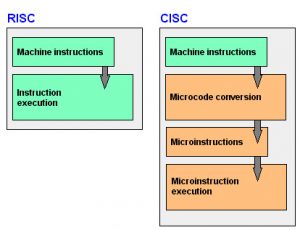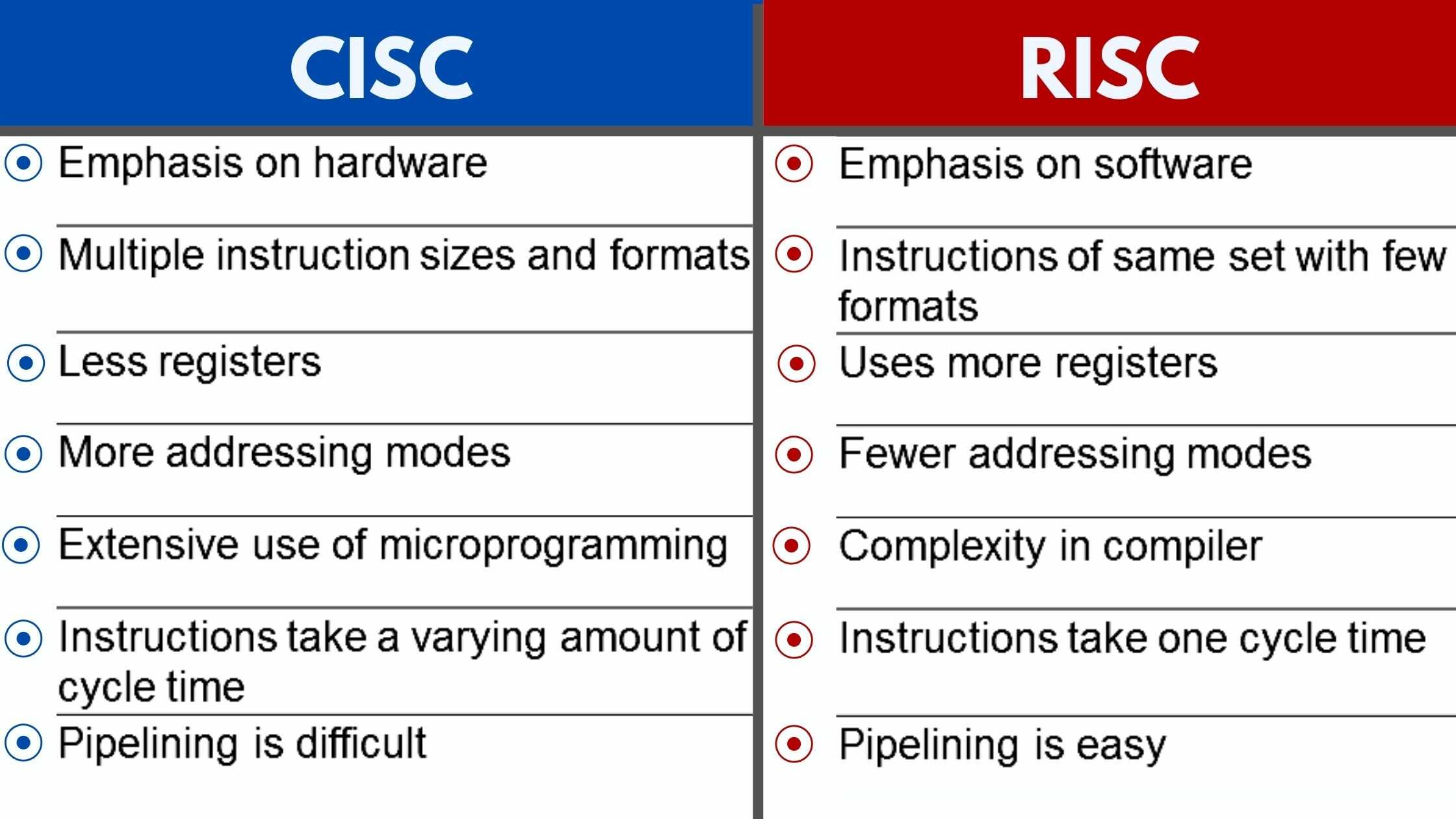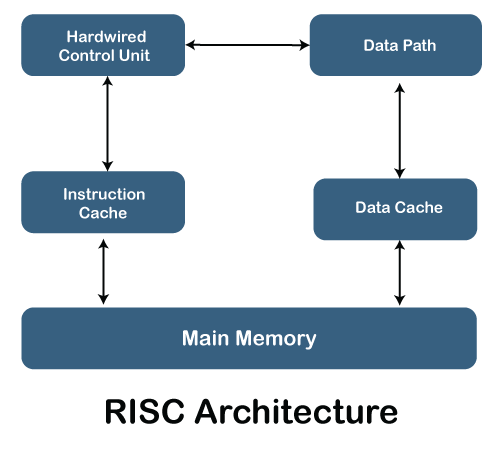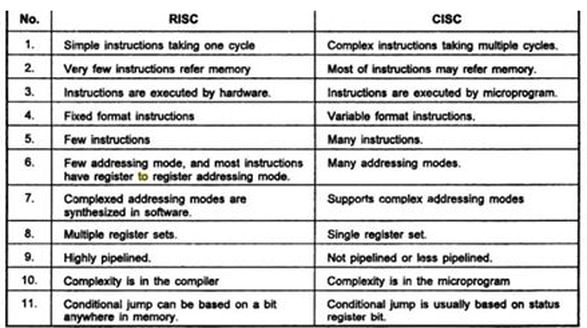Explain Difference Between Risc and Cisc Features
Most instructions single cycle. A Complex Instruction Set Computer CISC supplies a large number of complex instructions at the assembly language.

Computer Organization Ppt Download
It is actually a CPU which is capable of executing many operations through a single instruction.

. A common problem with building research processors is finding an ISA to use that isnt muddled with legacy decisions delay slots register windows isnt protected by patents and has enough opcode. Stands for Reduced Instruction Set Computing Stands for Complex Instruction Set Computing It has fewer instructions and a comparatively smaller instruction set. Reduce the cycles per instruction at the cost of the number of instructions per program.
RISC stands for Reduced Instruction Set Computer Whereas CISC stands for Complex Instruction Set Computer. 15 rows The RISC processors have a smaller set of instructions with few addressing nodes. It incorporates a variable-length instruction format.
It was developed by Intel. However both differ in various ways. It gives good performance along with a microprocessor system.
Operates on Register to Register. RISC designs start with a. RISC processors use a small and limited number of instructions.
RISC uses fixed format 32 bits and mostly register-based instructions whereas CISC uses variable format ranges from 16-64 bits per instruction. It implements parallel processing of instructions rather than using fixed-length instructions. CISC used a larger instruction set.
The RISC processors have a smaller set of instructions with few addressing nodes. It is an acronym for Reduced Instruction Set Computer. When we compare RISC and CISC theres no winner between RISC and CISC architecture it all depends upon the application and scenario of use.
CISC stands for Complex Instruction. RISC uses a single clock and limited addressing mode ie 3-5. The original idea behind RISC and CISC was that RISC used a smaller set of instructions which created a smaller processor.
This puts emphasis on software and compiler design due to the relatively simple instruction set. Comparing RISC vs CISC Architecture. Key Differences Between RISC and CISC.
Fixed number of instruction cycles. It comprises a complex instruction set. First one is RISC Reduced instruction set computing.
RISC machines mostly uses hardwired control unit. CISC focuses on hardware. CISC stands for Complex Instruction Set Computer.
Explain RISC in detail. RISC emphasizes efficiency by taking into account cycles per instructions whereas CISC emphasizes efficiency by the number of instructions in a program. It is open clean and easily extensible and also realistic.
RISC processors only support a small number of primitive and essential instructions. In RISC all instructions have simple register addressing and hence use less number of addressing modes. RISC have a large number of general purpose registers while CISC have special purpose registers.
A RISC microcontroller such as the PIC18F emphasizes simplicity and efficiency. In RISC the instruction set size is small while in CISC the instruction set size is large. CISC based computer will have shorter programs which are made up of symbolic machine language.
CISC Complex Instruction Set Computer. It is actually a CPU which is capable of executing many operations through a single instruction. 9 rows RISC.
RISC-V is a new ISA developed at Berkeley to assist in both research and education. RISC stands for Reduced Instruction Set Computer. It is a type of microprocessor that has been designed to carry out few instructions at the same time.
There is no need for an instruction to be executed by a miniprogram called microcode as on CISC processors. RISC is a design of Central Processing Unit that has the basis of basic instruction set. Difference between RISC CISC architecture RISC vs.
The standard features of RISC processors are listed below. The second one is CISC Complex instruction set computing. The working of EPIC processors is supported by using a set of complex instructions that contain both basic instructions as well as the information of execution of parallel instructions.
RISC and CISC architecture. Features of RISC Demands less decoding Uniform instruction set Identical general purpose registers used in any context Simple addressing modes Fewer data types in hardware. CISC There are two types of CPU architectures.
RISC focuses on software. The best features of RISC and CISC processors are combined in the architecture. The CISC processors have a larger set of instructions with many addressing nodes.
In RISC any register can contain either data or an address. Single clock reduced instruction only which means the instructions are simple compared to CISC. RISC has a small set of instructions which generally include register-to-register operations.
There are two types of this architectural design. It has more instructions and a more complex instruction set. CISC represents Complex Instruction Set Computer.
CISC is a type of design for the computers. CISC stands for Complex Instruction Set Computer.

Comparison Between Risc And Cisc ह न द Youtube
Difference Between Risc And Cisc With Comparison Chart

Difference Between Risc And Cisc Javatpoint

Is An 8085 Microprocessor Cisc Or Risc Quora

Pdf Risc And Cisc Semantic Scholar

Difference Between Risc And Cisc Architecture And Their Applications
Difference Between Risc And Cisc Pediaa Com

What Is Risc V 10 Things You Should Know About Risc V In 2020 Latest Open Tech From Seeed
How To Know A Microcontroller Is Cisc Or Risc Without A Data Sheet Quora

A Comparison Between Risc And Cisc Microprocessor Architectures Semantic Scholar

7 Difference Between Risc And Cisc Microprocessors

Difference Between Cisc And Risc Use Characteristics Advantages

Summary Of Risc And Cisc Trends Download Table
Difference Between Risc And Cisc Processor In Computer Architecture In Hindi Risc And Cisc

Difference Between Risc And Cisc Javatpoint

What Is The Difference Between Cisc And Risc Architectures

A Comparison Between Risc And Cisc Microprocessor Architectures Semantic Scholar


Comments
Post a Comment